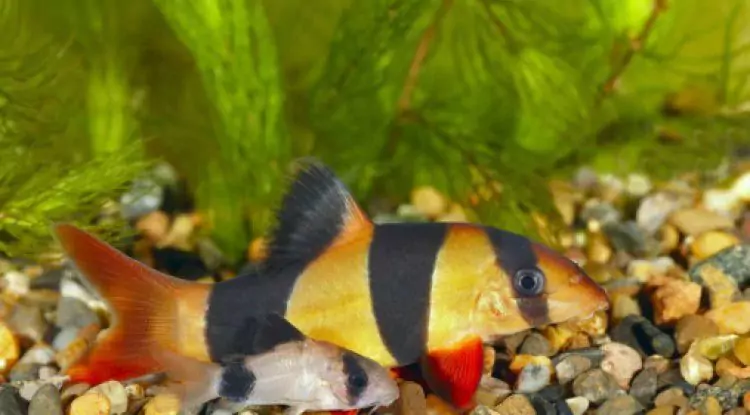The Cute Indonesian Freshwater Fish, the Increasingly Rare Clown Botia Fish
Clown botia fish are distributed in several freshwater waters in Indonesia. Its habitat is spread across Kalimantan and Sumatra.

The clown botia fish, whose scientific name is Chromobotia Macracanthus, is one of the freshwater fish can be found in Indonesia. This cute-looking botia is a species of tropical freshwater fish that is part of a single member of the Chromobotia genus.
This fish is spread across several freshwater waters in Indonesia. Its habitat is spread across Kalimantan and Sumatra. Here are some interesting things about botia fish.
Clown Botia Fish Habitat
Botia fish are generally distributed in several freshwater areas in Kalimantan and Sumatra. However, botia fish habitat is found in rivers in West Kalimantan, East Kalimantan, and Central Kalimantan. Meanwhile, in the Sumatra region, botia fish can be found around Jambi, South Sumatra, and Lampung.
Looking at its distribution, this water botia is usually found in the main river. However, this fauna was also found swimming upstream of the tributary to lay eggs. Usually, clown botia will lay eggs in the rainy season when some areas experience temporary flooding.
Adult botia fish are usually found at the bottom of rivers. This fauna is often found hiding under rocks or mud cavities in rivers. Meanwhile, young botia fish are more often found around flood waters or live more on the surface.

Characteristics of Clown Botia Fish
In general, clown botia fish have an elongated, round body shape. Usually, these botia are colored red, yellow and orange. There are several vertical lines on the clown botia fish. The back of the Botia fish is predominantly black, while the bottom has yellow as a pattern.
Morphologically, botia fish have a relatively bright body color. The characteristics of the clown botia fish are yellow with three black stripes like a zebra. One black line on the clown botia usually passes through its eyes, while the other black line is located in front of the dorsal fin to the base of the tail.
Most clown botia fish have red, orange, and black fins in the Kalimantan clown botia fish. Meanwhile, in the Sumatran clown botia fish, the fins are usually all reddish. The color of the fins helps the freshwater botia camouflage with plants in the water.
The head of the botia fish tapers slightly towards the mouth. The botia fish's mouth is slightly downwards, with four pairs of tentacles near its mouth. Apart from that, the bodies of these aquatic fauna also do not have scales.
For body size, clown botia is classified as a medium-sized fish. This fish can grow more than 40 cm. However, the average size of adult clown botia fish is between 20-30 cm. Meanwhile, the largest weight achieved by the clown botia fish species is around 469 grams.
Clown Botia Fish Food
Basically, clown botia fish are known as carnivores or meat eaters. However, this freshwater fish also wants to eat plants. This is what ultimately underlies the opinion that botia fish are omnivorous.
In general, in the wild, clown botia fish will eat green plants and aquatic animals found in fresh waters. However, if cultivated, botia fish can be fed in the form of pellets, crushed fish or shrimp, or worms. Meanwhile, for plant foods, you can give lettuce, spinach, and other green plants.
Clown Botia Fish Population
As stated above, the native habitat of the clown botia fish is spread across Kalimantan and Sumatra. However, this fish is actually threatened in its natural habitat. This is because overfishing means that the clown botia fish population continues to decline yearly. Environmental degradation due to human activities has also impacted the decline in the clown botia fish population.

Cultivating Clown Botia Fish
As time goes by, clown botia fish can now be cultivated. However, it takes some skill to breed these cute freshwater fish.
One of the most important tips for cultivating botia fish is to arrange a place for the botia fish to live. When cultivating it, ensure the water used is not mixed with chemicals and change it regularly. The goal is that the clown botia fish can stay alive without being attacked by disease, considering that botia fish have sensitive skin.
If you breed botia fish in an aquarium, make sure it is large enough, with a tank of around 450 liters. In the aquarium, you can add gravel or sand by maintaining a temperature of 24-27 degrees Celsius and a pH of 6-6.5. Additionally, aquatic plants can also be used to give fish a place to rest.
Cultivating clown botia fish does require more skills. Because they like good water aeration, try to always keep the water flowing smoothly for botia fish. Within a certain age, group botia fish into small and large sizes. This aims to prevent the fish from experiencing stress.
For those of you who breed clown botia fish, there are certain times that are recommended for spawning. Spawning of botia fish can be done during the rainy season, around December to February. Because previously, botia fish would migrate to smaller tributary streams from September to October.
However, cultivating clown botia fish in an aquarium tends to be complicated. This is because the water content in the aquarium is different from that in the wild. Usually, botia fish breeders give special hormone injections to breed botia fish in an aquarium.
Botia Clown image source:
https://media.istockphoto.com/id/1369612139/photo/large-clown-loach-isolated-in-fish-tank-with-blurred-background.webp?b=1&s=170667a&w=0&k=20&c=3sEh- aZGvQ13K30ttJxx3DYyHXm2KsQVVv0HKP_xCYM=
https://media.istockphoto.com/id/1345307804/photo/chromobotia-macracanthus.webp?b=1&s=170667a&w=0&k=20&c=Bo_gaJsXGH10sCBoy2RSJOTYkpjG9Xtv4DpPPIU7zg4=

 marezasutan
marezasutan